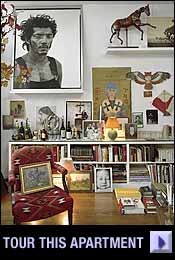
For the past 34 years, on a quiet block on the Upper East Side, many of the most important figures of our time—and some of its greatest beauties—passed through the arched entrance to Richard Avedon’s studio. Elizabeth Taylor, Truman Capote, Allen Ginsberg, Hillary Clinton, and Nastassja Kinski would all be greeted by the studio manager and head to the waiting area: a couple of black director’s chairs under a giant print of Dovima With Elephants, the most famous of Avedon’s fashion photographs.
It was easy to miss the door opposite the studio manager’s desk, which led to a steep, narrow staircase that went up to Avedon’s apartment. Extremely guarded about his personal life, the photographer, who died in October at the age of 81, invited only a small group of family and friends to make the climb.
At the top, where he’d always be waiting to say hello effusively, was a floor-through one-bedroom, in which any semblance of decorating was merely a by-product of Avedon’s desire to have the things he loved close at hand. The place was an exercise in creative juxtaposition: Navajo blankets and a Vuillard, ivory animal-head bottle stoppers next to brass-plated sculptures of cameras, an homage to Giacometti above the toaster oven. It was theatrical in the best sense of the word: a 2,000-square-foot cabinet of curiosities.
Avedon purchased the former carriage house in 1970. (It’s now up for sale, and an auction of much of its contents is being planned at Sotheby’s.) Architect Harris Feinn’s initial renovation included building out a terrace garden on the second floor and putting a skylight over the kitchen. The photographer approached the apartment as if he were directing a shoot: Marla Weinhoff, who’d produced sets for Avedon, found antiques like the red Oushak carpet in the living room. Lighting designer William Riegel (who’d worked for Studio 54) devised a system whereby, at the touch of one button, every light would go on simultaneously. Avedon often placed lights in unusual places, like a table lamp on the floor. “He wanted areas of light and dark,” says Riegel. “The shadows were just as important to him.”
The apartment was a series of still-lifes—seen here as they existed—but still-lifes that almost always had a certain functionality: stacks of books he wanted to consult, a set of magnifying glasses. There was nothing overtly decorative about the arrangements. And the photographs of his own that Avedon put up tended not to be his beautiful fashion shots, but tougher portraits, like the one in the living room, from his book that effectively de-romanticized the American West.
But the house also had a sense of humor. Peering out from the plants in the terrace garden by the kitchen is Avedon’s glass-covered portrait of Charlie Chaplin, taken on the eve of the actor’s flight from America. It’s another unexpected yet perfectly logical juxtaposition—the picture goes beautifully with the bird-feeder.
